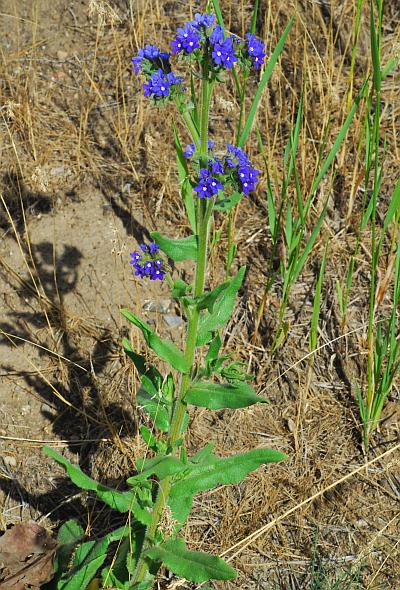Anchusa officinalis L.
Common Bugloss

Introduced
CC = *
CW = 5
MOC = 1
© SRTurner
Anchusa officinalis L.Common Bugloss | |
 |
Introduced CC = * CW = 5 MOC = 1 |
© SRTurner |
|
Family - Boraginaceae Habit - Perennial forb with somewhat woody, stout taproot. Stem - Ascending to erect, to 1 m, solitary or several, unbranched below the inflorescence or branched toward the base, pubescent with spreading to ascending, bristly, pustular-based hairs.
Leaves - Alternate and basal, simple. Basal and lower stem leaves narrowly oblanceolate to narrowly oblong-oblanceolate and long-tapered to a winged petiole. Median and upper leaves gradually reduced, linear to narrowly lanceolate or lanceolate, sessile and angled to rounded at the base, sometimes slightly clasping the stem. Blades 1-20 cm long, 6-20 mm wide, moderately to densely pubescent with spreading, bristly, pustular-based hairs. Inflorescences - Panicles with ascending or arching, scorpioid, spikelike racemes. Inflorescence bracts 6-12 mm long, 0.8-1.2 mm wide, linear, moderately to densely bristly-hairy. Flower stalks 1-2 mm long at flowering, elongating to 3-5 mm at fruiting, ascending.
Flowers - Calyces actinomorphic, 5-lobed, 6-10 mm long at flowering, divided nearly to the base, the lobes elongating to 12-18 mm at fruiting, densely pubescent with spreading, bristly, pustular-based hairs. Corollas funnelform, actinomorphic, 5-lobed, 12-17 mm long, the tube 7-10 mm long, bright blue to purple or reddish purple, the throat with the scales white to lavender or pale blue and usually with dense, short, club-shaped hairs, the lobes 3-5 mm long. Stamens attached above the midpoint of the corolla tube, the filaments very short, the anthers oblong, positioned at about the level of the scales, not exserted from the corolla. Ovary deeply 4-lobed, the style slender, not exserted from the corolla, often more or less persistent at fruiting, the stigma capitate, somewhat 2-lobed.
Fruits - Schizocarps dividing into 2-4 nutlets, these 3-4 mm long, 2-3 mm wide, angled obliquely, ovoid, bluntly pointed at the tip, the surface more or less wrinkled and/or with blunt tubercles, attached to the relatively flat gynobase at the base, the attachment scar with a short, stalklike projection and surrounded by a collarlike ring, the surface appearing variously wrinkled, ridged, and/or tuberculate, white to grayish white.
Flowering - April - June. Habitat - Open disturbed areas. Sometimes cultivated. Origin - Native to Eurasia and Africa. Lookalikes - None. Other info. - This distinctive plant is rare in Missouri, having been reported only once (in 1892) from the wild. It is likewise uncommon across the U.S., except in portions of the Pacific Northwest, where it is fairly common. It is easily identified by its overall bristly hairiness and inflorescences of small, 5-lobed blue flowers. Photographs taken in Spokane, Spokane County, WA, 6-13-2015 and 8-15-2019 (SRTurner). |